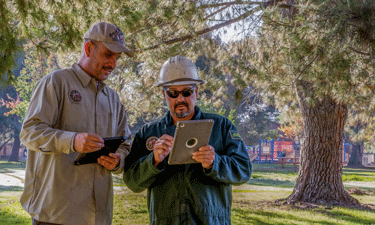 Like any park asset, trees need careful management. Would you run your community pools without tracking chemical costs? How efficient would your mechanics be if they didn’t log maintenance to trucks, mowers and other equipment? Trees need the same consideration if you want to get the most long-term value out of their ability to shade, filter stormwater, block sound pollution, provide wildlife habitat and perform other services within your park.
Like any park asset, trees need careful management. Would you run your community pools without tracking chemical costs? How efficient would your mechanics be if they didn’t log maintenance to trucks, mowers and other equipment? Trees need the same consideration if you want to get the most long-term value out of their ability to shade, filter stormwater, block sound pollution, provide wildlife habitat and perform other services within your park.
Laura Bauernfeind, principal forester for Los Angeles Department of Recreation and Parks, wanted a better method for managing the hundreds of thousands of trees spread across the parks’ 16,000 acres throughout the city and southern California.
“In order to manage something and care for something, you have to know what you have,” Bauernfeind says. “You need to have an inventory and system in place to manage your priorities and track that valuable infrastructure.”
That’s why L.A. City Parks partnered with The Davey Tree Expert Company for the use of TreeKeeper, Davey’s proprietary web-based tree-management software.
“TreeKeeper helps us manage our resource but also manage our priorities,” Bauernfeind says. “It’s also an extremely invaluable risk-management tool.”
Davey’s software suite gives park directors and foresters the tools to manage an existing tree inventory, administer work orders generated internally, compile flexible data reports and manage calls from residents of a community, all on mobile platforms.
The software includes an integrated mapping program. GIS mapping pinpoints each tree within a jurisdiction. TreeKeeper’s ability to run on iPads, Toughbooks and other tablets allows personnel to work with real-time data updated in the field to reflect inventory additions, maintenance work such as pruning, plantings, removals, storm damage and other data fields.
Dana Karcher, market manager for Davey Resource Group, a division of Davey Tree, said TreeKeeper’s flexibility allows L.A. City Parks to tailor data reports by almost any category from tree species to age, forest density and maintenance frequency.
“By developing reports about where she may be lacking trees, Bauernfeind can determine where they should be planting new trees,” Karcher said. “She can also look at species balance to see what else she should be planting to level out the different types of species she has throughout the parks.
“Species diversification is very important to manage against pests, disease, and in Southern California, drought,” Karcher said. “With the emerald ash borer marching across the country, and polyphagus shothole borer already in the region, it becomes incumbent upon tree managers to track what they are planting and how those trees are performing.”
Bauernfeind estimates that L.A. City Parks is responsible for a minimum of 337,600 trees. Of those, the parks worked with Davey to inventory about 60,000 to date.
“Right now, we’re primarily using TreeKeeper to host our tree inventory data,” Bauernfeind says. “By the time this goes to press, we will be using it to manage our work order system. From a managerial standpoint, the ability to have a permanent record of the work that we’re doing on a tree-by-tree basis so that we can prioritize our work is invaluable. And the fact that it’s electronic so staff can be dispatched without the need for paper, and that everything is being accurately logged in real time, makes the work that much easier.”
Using iPads, Bauernfeind’s staff can take pictures of tree damage, planting and maintenance and instantly input the photos into TreeKeeper to supplement the other data tracked by the software. The ability of staff to quickly update the software in the field lets administrative personnel work with real-time data when planning responses to storms, wildfires and other weather events or managing construction and expansion projects.
Davey and L.A. City Parks are working on a pilot project using TreeKeeper to track drought effects. The parks are experimenting with tree-growth regulators to determine if they can potentially ease the stress on trees struggling with drought. TreeKeeper tracks which tree species in what locations are being tested and will log the results over time.
Just as importantly, the inventory quantifies the value of a forest that may be destroyed by a fire and provides a comparative analysis of the loss.
The software also includes an educational component.
In fall 2014, the Department of Recreation and Parks made its existing tree inventory data available to the public online.
“Our goal is to help educate the public about the value, importance and extensive nature of the park urban forest,” Bauernfeind said. “It potentially could be a huge educational component as well for us to leverage and educate local politicians.”
Karcher credits L.A. City Parks’ staff with embracing the software and taking a smart, progressive approach to managing its tree population.
“L.A. City Parks is a quiet leader in urban forestry in California,” she says. “L.A. City Parks manages a lot of trees for many citizens. In many cases we take for granted the trees in our parks, but the L.A. Parks team does a great job of assuring that residents and visitors alike have a healthy urban forest when they come to enjoy the numerous parks throughout the city of Los Angeles.”
Matt Fredmonsky is a Corporate Communications Project Manager for The Davey Tree Expert Company.

